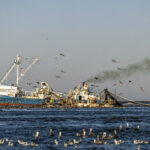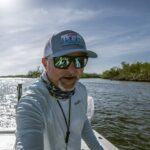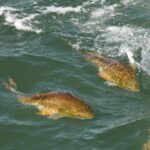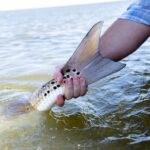
Gulf Menhaden Reduction Fishery: Bycatch Research & Useless Buffer Zones
Do you remember your driver’s test? How nervous were you when the instructor pulled out
Feature Photo: Captain Mike Holliday puts a Cobia in the boat off the beach of Stuart, Florida a few seasons back.
Striped bass dominated last week’s ASMFC meeting and the ASGA airwaves. If you haven’t already, be sure to check out our breakdown of the Striped Bass Board Meeting by clicking here. It was an undoubtedly big day for striped bass. However, there was another important discussion at the Winter 2024 ASMFC meeting that we were paying attention to: an Atlantic Cobia Recreational Reallocation Addendum.
Whether you’re throwing jigs at fish trailing rays or sight casting them off pilings with fly gear, cobia are a great fish to catch and make great steaks, too. In regions like Virginia, they are incredibly popular. Seeing hundreds of boats sporting aptly named “cobia towers” is not uncommon. The species is not doing great, and management is struggling too. According to the most recent stock assessment (2020), cobia are not overfished or subject to overfishing, but the species’ biomass is declining towards the overfished threshold. A new Benchmark Stock Assessment is slated to be completed in early 2026.
Put simply: cobia frustrates fisheries management, as the stock appears to be expanding its range northward and is incredibly difficult for data collection services (Marine Recreational Information Program and other state programs) to capture due to the pulse/rare event nature of the fishery. Along the Atlantic Coast, Cobia is managed by the ASMFC (previously, it was under the jurisdiction of the South Atlantic Fishery Management Council, but the management plan was transferred to the ASMFC, leading to far less accountability and contributing to an uncertain future). Usually, on three-year cycles, the ASMFC sets harvest targets for the recreational cobia fishery; Virginia through Georgia are allocated state-by-state “soft harvest targets” with specific bag/size/season measures, and other states operate under de minimis management because of low historic landings. States like New Jersey, New York, and even Rhode Island are seeing more and more cobia in recent years—climate change, water temps, bait abundance?—prompting a need to revisit the current management system partly because their landings are exceeding de minimis thresholds.

Back in October 2023, the ASMFC’s Coastal Pelagics Board initiated this Recreational Reallocation Addendum to address the shifting distribution of Atlantic cobia landings and to explore alternatives to the current state-by-state allocation/harvest target approach. So, the Cobia Plan Development Team got to work and presented their initial progress to the CMP Board this past week at the Winter 2024 ASMFC Meeting.

In its memo (starts on pdf page 26) and at the meeting, the PDT discussed three allocation alternatives for the addendum:
Now, it’s important to note that this Addendum and these options are still very preliminary. The board has not approved anything for public comment yet and the PDT will further refine these ideas. But let’s review the Board’s discussion about these ideas/alternatives.
We heard some very real concerns and comments from the board, but the group was ultimately all on board for moving this process forward and implementing new allocations for 2025. A recurring comment was regarding the notable recreational data challenges with Cobia, the potential for estimation bias with MRIP’s Federal Effort Survey, and uncertainty with the program in the near future. This is totally fair because Cobia have challenged managers and scientists for years: MRIP performs poorly with rare-event, pulse fisheries that are predominantly prosecuted on private vessels. Additionally there is some uncertainty in the short term, as MRIP conducts a larger-scale study to evaluate potential estimation bias, and more potential uncertainty in the long term, if overestimation bias in MRIP is confirmed.
Other Board member comments included concerns about not knowing future allocations under an adaptive trigger mechanism, desire to limit constant management change “whiplash,” how to address management uncertainty, whether to allow conservation equivalency, and support for a straightforward coastwide management system. The fact remains that something needs to be done to improve coastwide cobia management, and the Board agreed to continue developing this action.
Reallocation is a challenging activity for fisheries management, but a necessary one to ensure effective, sustainable management, especially when involving stocks shifting out of their historic range and data disruptions. We’ll be paying attention as this Addendum develops over the next couple of months and will provide updates going forward.

Do you remember your driver’s test? How nervous were you when the instructor pulled out

If you’ve spent any time on the water in South Florida, chances are you’ve heard

Photo Credit: Graham Tayloe Big Win for Redfish in Alabama Huge news from the Marine

Feature Photo: Carter Abramson | Simms Fishing at the Fisheries Science Symposium We have more
We rely on our members and donations to keep fighting for a sustainable tomorrow in marine conservation.
GIVE THE GIFT OF FISHERIES CONSERVATION THIS HOLIDAY SEASON. SHOP ASGA GOODS THAT FUND FISHERIES RESEARCH & ADVOCACY CAMPAIGNS
JOIN ASGA IN CALLING FOR CRITICAL MANAGEMENT ACTION AFTER YEARS OF SPAWN FAILURES & POOR MANAGEMENT.
By using this website, you agree to our use of cookies. We use cookies to provide you with a great experience and to help our website run effectively. To learn more, please review our privacy policy.